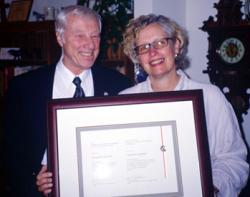
I believe that Mr. Charles Garrad exemplifies the caliber of avocational archaeologist envisioned by both the CAA and the Pendergast family. Indeed, I feel that Jim would have been proud to see the initial award go to someone who has made a comparable contribution to Canadian archaeology; not to mention a friend and research associate.
Charles was born in England in 1930 and, similar to Jim, served in the military. Following a three year stint in the Royal Army Service Corps, he emigrated to Canada in 1954. During the construction of his ski cabin at Blue Mountain he became interested in local archaeological sites and, with his mentor Jay Blair, began field work in 1961. He helped establish the Archaeological Society of Western Ontario while living in London and published his first articles in their bulletins in 1964 and 1965. Ultimately, he was to write well over 200 articles and reports (to this point in his career), with a dozen being published in peer reviewed journals and volumes.
From the beginning, Charles has shown a strong interest in the archaeology of the Blue Mountain region of Ontario. He has become the expert on the Petun over the last 40 years, as evidenced by an invitation from Dr. Bruce Trigger for him to co-author "The Khionontateronon (Petun)" chapter in the 1978 Smithsonian Handbook of North American Indians, Northeast volume.
Perhaps his most lasting contributions to our knowledge of the Petun will be his legacy of massive Ontario archaeological licence reports, as well as the numerous bulletins of his Petun Research Institute. It is difficult to adequately summarize the work of so prolific an author; however, mention should also be made of his pioneering work on fluted point distributions in Ontario and contributions to the history of Ontario archaeological research.
Charles has delivered numerous presentations and workshops to a wide variety public groups. He has been a major force in the Ontario Archaeological Society, serving as President in 1974 and Executive-Director from 1979 to 1996. He was a member of Ontario's Archaeological Conservation Programme throughout that program's existence and helped to launch and promote the "Passport to the Past" volunteer program for the OAS. Both provided avocational archaeologists with an opportunity to make meaningful contributions to Cultural Resource Management in Ontario. Charles has provided development planning input to a variety of federal, provincial, and municipal agencies and has worked with a wide variety of academic archaeologists in Canada, the U.S.A. and Europe, sharing his unique knowledge. Perhaps his outstanding contribution to the communication of archaeological values and principles has been through his pioneering and continuing positive relations with First Nations; particularly the descendants of the Petun/Wyandot peoples, most of whom live in the United States. As early as 1975, Charles was adopted into the Wyandotte Tribe of Oklahoma for his contributions to their reawakened interest in their early history. Subsequently, in 1999, he was adopted into the Wyandot Nation of Kansas. Thus, it is no surprise that Charles Garrad has already been the recipient of Ontario's two highest awards for avocational contributions to archaeology - the J. Norman Emerson Silver Medal for Excellence in Archaeology (1990) and the Peggi Armstrong Public Archaeology Award (1997).
I can only conclude by saying that I am aware of no one else in Canada more deserving of the Margaret & James F. Pendergast Award.
Sincerely,
William A. Fox
March 14, 2001
